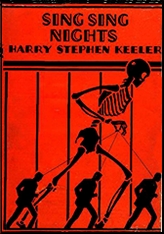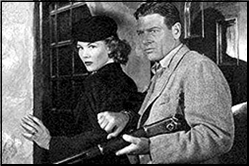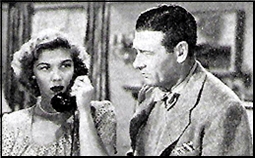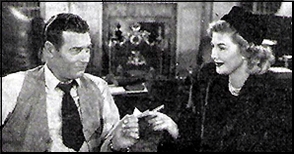Wed 11 Jul 2018
A TV Series Review by Michael Shonk: THE SANDBAGGERS (1978, 1980)
Posted by Steve under Reviews , TV Espionage & Spies[17] Comments
THE SANDBAGGERS. ITV/Yorkshire Television. First Series: September 18, 1978 – October 30, 1978; second series: January 28, 1980 – March 3, 1980; third series: June 9, 1980 – July 28, 1980. Created by Ian Mackintosh. Cast: Roy Marsden as Neil Burnside, Ray Lonnen as Willie Caine, Bob Sherman as Jeff Ross, Alan MacNaughtan as Sir Geoffrey Wellingham, Jerome Willis as Matthew Peele. Executive Producer: David Cunliffe. Producer: Michael Ferguson (all episode but one) or Derek Bennett (one episode).
Forgotten today, the British TV spy series THE SANDBAGGERS remains one of television’s greatest spy dramas. THE SANDBAGGERS featured a dark realism style. It was a cynical spy drama that existed during a time when it was difficult to know who the good guys were. THE SANDBAGGERS showed life in the real SIS (MI5) and gave a more truthful look at both sides during the Cold War then they taught us in school.
The series was originally meant to be a temporary fill-in when another planned series for Yorkshire TV fell apart. THE SANDBAGGERS was to last only one series (series is the British term for season) of seven episodes. It would prove popular enough to last two more series and would have made a fourth if not for the mysterious disappearance of creator and probable spy Ian Mackintosh.
In an outline attempting to sell the premise as a TV series Mackintosh described the series primary focus would be “with the triumphs and failures of SIS headquarters, the power-struggles within SIS itself and the uses and abuse of its power vis-à -vis Government policy.â€
It is impossible to think of THE SANDBAGGERS without Ian Mackintosh. Hamish Ian Mackintosh MBE (July 26, 1940 – last known alive July 7, 1979) served in the Royal Navy from 1958-1976 and rose to the rank of Lieutenant Commander. On his retirement from the Royal Navy he was appointed a Member of the Order of the British Empire (MBE).
Mackintosh tried writing while still in the Navy and his first of five thrillers A SLAYING IN SEPTEMBER was published in 1967. All five were failures with critics and readers and our own Mystery*File reviewer Steve, which you can read here.
In 1973 Mackintosh co-created the admired BBC TV series WARSHIP (1973-1977). Ian would go on to create and write WILDE ALLIANCE (ITV 1978), THUNDERCLOUD (ITV 1979) and THE SANDBAGGERS, all three for Yorkshire Television. He also wrote tie-in novels for WARSHIP, WILDE ALLIANCE and THE SANDBAGGERS. One other tie-in novel for THE SANDBAGGERS was THE SANDBAGGER: THINK OF A NUMBER (1980) written by Donald Lancaster (YELLOWTHREAD STREET writer William Marshall). Ian also wrote some non-fiction books many featuring his interest in planes and military history.
While Ian Mackintosh was the creative spirit behind the success of THE SANDBAGGERS others played equally important roles in the series success. David Cunliffe had worked in British television since the 1950s. He first met Mackintosh when both worked on the series WARSHIP and became friends. Cunliffe was the Controller of Drama at Yorkshire Television and worked with Ian on all three YTV series Mackintosh created and wrote. Yorkshire Television was the local Leeds and Yorkshire area ITV affiliate and produced television programs for ITV including such series as HARRY’S GAME, THE MAIN CHANCE and RAFFLES. Cunliffe was in charge of every aspect of THE SANDBAGGERS including final script approval.
Derek Bennett was the director and producer for the first episode filmed (the third episodes aired) IS YOUR JOURNEY REALLY NECESSARY but a disagreement between Bennett and Mackintosh forced Derek to leave. Michael Ferguson would replace Bennett. Cunliffe turned daily production decisions over to Ferguson who as producer and sometime director would remain for the entire run.
Not surprisingly for British TV, at the time the series had a low budget and sometimes it showed. During series one Roy Marsden was the highest paid in the cast making around $1900 an episode.
The soundtrack was a positive aspect of the series. It did not have one (with rare exceptions). Often such absence of music (not unusual for early British TV) can make scenes seem awkward or slow paced, but it worked to this realistic drama’s advantage. TV and film spies are known for great theme songs and THE SANDBAGGERS has one of the best, written by Roy Budd (GET CARTER).
Roy Marsden (P.J. JAMES’ ADAM DALGLIESH CHRONICLES) was the perfect fit and first choice to play Neil Burnside — the ruthless, arrogant Director of Operations. Marsden modeled his portrayal of Burnside on his observations of Mackintosh. It was a good choice as Marsden gave Burnside a depth and allowed the audience to still root for and respect the at times unlikable character.
Burnside had two advantages in running the SIS operations. His first was based on the very real special relationship the SIS had with the CIA. The CIA respected the opinions of the SIS and thus shared information with the small British agency that it shared with no other country or agency. This gave Burnside information others did not have.
Head of London Station for the CIA was Jeff Ross. Ross and Burnside worked well together and respected each other but that did not stop both from using the other when it was in the best interest of their agency.
The second advantage was more personal. Burnside was the ex-son-in-law and still a friend of the Foreign and Commonwealth Secretary Godfrey Wellingham who in the government chain of command was above both of Burnside’s bosses Director – General or “C,†and the Deputy Director of SIS. Wellingham had hopes Burnside and his daughter would reunite but also realized Neil had chosen his work over his marriage.
The first “C†of the series was Sir James Greenley, whose lack of spy experience left him naive at times about the reality of the world of SIS. Burnside would grow to respect him. Greenley trusted Neal’s judgment and experience even if he was horrified by the immorality of their actions. Greenley would retire due to health problems and was replaced by John Tower Gibbs, a long time opponent of Burnside.
The Deputy Director was Matthew Peele who served in intelligence during WWII, ambitious, clueless, and someone Burnside usually found easy to manipulate.
The confident and determined Burnside often went over the heads of his SIS bosses to use his ex-father-in-law influence, and he had no problem lying to all of them if it suited his vision of what was right and how to handle the problem.
The gratuitous sex, over the top violence, and absurdly complicated gadgets of James Bond was fiction in this world. This was a world where work in the field could be dull but was always dangerous. The turnover of Special Agents (field agents at SIS) was high during the series.
Due to the SIS small budget Burnside had only one to three Special Agents at a time. It takes a special person to become a SIS Special Agent, these were the agents who were assigned the dirty jobs no one else wanted or could handle.
Head of Special Section (Sandbagger One) was Willie Caine, a womanizing, working-class, ex-military with a strong moral code. Willie and Burnside respected each other but also had major disagreements over Burnside’s methods. Ray Lonnen (HARRY’S GAME, YELLOWTHREAD STREET) was able to make spy Willie Caine a sympathetic human living a life of loneliness but surviving because of his pride in his work.
The series featured believable characters, realistic dialog and plots that were cynical with dramatic twists that can sometime still surprise forty years later. The focus was less on the Russians and more on the self-interest power plays among the British government and its allies.
“Special Relationship” was the scheduled final episode for this fill-in TV series. It is arguably the best episode of the series and certainly the most important. The cast strongly objected to the story’s ending. However, the critics and public’s reaction lead Yorkshire TV to approve THE SANDBAGGERS for another series of six episodes. Shortly after that Yorkshire added seven more episodes and two weeks of location shooting at the luxurious Malta.
Roy Marsden commented on the reaction to the episode, saying, “When “Special Relationship” was shown, the response all over the country was staggering. Every radio program was taking about what had happened.â€
“Special Relationship” (October 30, 1978) Written by Ian Mackintosh. Directed by Michael Ferguson. Additional Cast: Diane Keen as Laura Dickens and Richard Vernon as Sir Greenley. *** Burnside and agent Laura Dickens have fallen in love. During an assignment in East Germany Laura is captured. Burnside searches for a possible prisoner in Allies hands to exchange for Laura. He finds one but there is a price.
Due to a labor strike that forced Yorkshire and ITV off the air for two months and the disappearance of Mackintosh, it would be fourteen months after the first series aired that THE SANDBAGGERS returned to the air. It had been decided to split the thirteen episodes up into two series. The second series aired six episodes from January 28 to March 3, 1980. The final seven episode third series aired from June 9 to July 28, 1980.
It was July 1979, six episodes for the second series had been filmed and Mackintosh had finished the scripts for all of the rest of the scheduled episodes but three. This is when the cast and crew headed off for two weeks of on location filming in Malta. David Cunliffe remained behind to run his other series for Yorkshire. Producer Michael Ferguson remained in London dealing with production work.
Ian decided to take a break. Mackintosh loved to travel, as did his girl friend of over two years Susan Insole. Mackintosh’s family and friends were used to him disappearing for a while and then suddenly reappearing. For this trip they had invited an old friend of Mackintosh British Airways pilot Graham Barber.
The trip would take them to the United States mainland and then to Hawaii and finally back to London by Alaska. They were flying over the Gulf of Alaska, an area of beautiful sights and an area of intense interest of both sides during the Cold War. The weather was clear and the waters calm when Graham Barber radioed an emergency call for help, “We are going down in the sea. I’m going to make for the very, very, small island just to the east of Shuyak Island.â€
The plane, a Rallye 235, and its three passengers were never found.
A lack of proof of death and Mackintosh’s long habit of disappearing and returning without warning put everything on an awkward hold. Reportedly the American state department held meetings discussing the possibility Mackintosh had defected to the Russian. Even today Ian’s brother Lawrie does not believe Ian died in the plane crash.
Series Two began with a less confident Neil Burnside who was more protective of his Special Agents. Below is the sixth and final episode of the second series and is a good sample of the characters and how Mackintosh’s SIS worked.
“Operation Kingmaker.” (March 3, 1980) Written by Ian Mackinston. Directed by Alan Grint. Additional Cast: Dennis Burgess as John Tower Gibbs and Elizabeth Bennett as Diana Lawler/ *** Burnside learns an enemy from his past John Gibbs may become the new “C.†Neil attempts to maneuver the system to install a boss he can control. His desperate choice is the ambitious idiot Matthew Peele, current Deputy Director.
Eventually Cunliffe could no longer wait for Ian’s return and with three episodes left that needed to be written, Cunliffe hired two writers to write the needed episodes. Gidley Wheeler (WARSHIP) wrote two episodes, MY NAME IS ANNA WISEMAN and WHO NEEDS ENEMIES. Arden Winch (WINGS) did SOMETIMES WE PLAY DIRTY TOO. All three were passable adventures but were too heavy-handed and lacked the style of Mackintosh.
Mackintosh had alreadyfinished the script for the last episode. Oddly enough for a man about to disappear, the episode ended in a cliffhanger. It is also one of Ian’s weakest scripts and suffers from believability issues.
“Opposite Number.” (July 28, 1980) Written by Ian Mackintosh. Directed by Peter Cregeen. Additional Cast: Michael Cashman as Mike Wallace and Sue Holderness as Marianne Straker *** Burnside has grown weary of the constant fighting within the system. As a long passionate opponent of the Salt talks (Strategic Arms Limitations) Neil decides destroying his career was a worthy price to pay if he can get the Russians to leave the talks.
The cliffhanger was not a surprise since Mackintosh expected a fourth series. Lonnen had signed for a fourth series. It is believed that Ian’s plans for series four had Willie promoted to Director of Operations and Burnside would become “C.†But without Ian Mackintosh the decision was made to end THE SANDBAGGERS. Cunliffe, Ferguson and Marsden moved on to do the series AIRLINE.
Some today wonder how popular THE SANDBAGGERS really was if so few who watched TV at the time remember it. Not having access to the ratings of 1978 or 1980 I suspect THE SANDBAGGERS critical acclaim had more to do with its success than number of people watching.
THE SANDBAGGERS did appear on American television in the late 1980s and inspired some enthusiastic fan clubs. It currently can be seen on streaming service BritBox.
On October 12, 2003 appearing in the New York Times was “TELEVISION; Spies Who Were Cool and Very Very Cold†by Terrence Rafferty. He wrote:
Whatever happened to Ian Mackintosh, Susan Insole and Graham Barber will most likely remain a mystery, but it left us all with a story worthy of an episode of THE SANDBAGGERS.
SOURCES:
THE LIFE AND MYSTEROUS DEATH OF IAN MACKINTOSH: THE INSIDE STORY OF THE SANDBAGGERS AND TELEVISION’S TOP SPY by Robert G. Folsom (Potomac Books, 2012).
Wikipedia
JOHN O’GROAT JOURNAL AND CAITHNESS COURIER (3/1/13) “Did Spy Writers Disappearance Mirror His Fiction?†by Calum Macleod
NY TIMES (10/12/03) “Television Spies Who Were Cool and Very Very Cold†by Terrence Rafferty




